Zero Waste at Nola’s Stockholm Furniture Fair Presentation
2023–04–06
2023–04–06
Nola’s initiative at the recent Stockholm Furniture Fair was designed to make our participation as waste-free as possible. Our products weren’t displayed in a trade fair stand that had to be built, but presented in a public area as seating clusters where people could meet, converse, eat and drink. By deciding against constructing the seating areas with building materials, we eliminated post-construction waste from the start. Our approach challenged the way that products and the public can interact, which shifted the belief that post-construction waste is inevitable at trade shows.
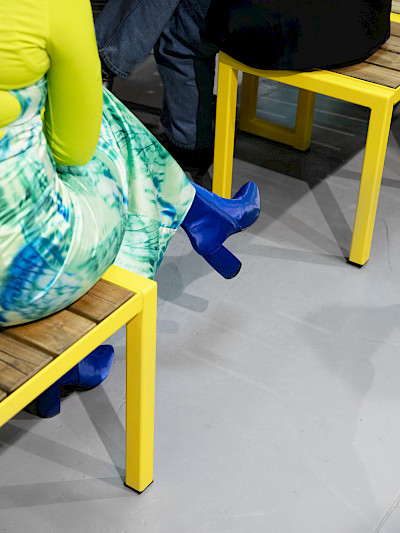
Following the pandemic, and subsequently the cancellation of furniture fairs in Stockholm and elsewhere, Nola recognized an opportunity to move away from a traditional stand. We decided to take our products into arenas where some visitors could maintain social distancing and where others could sit close together. The initiative to present products in public spaces gave us an opportunity to try something new, express something more authentic and create more value for the visitors. At the same time, we drastically minimized the amount of waste we generated at the fair.
”Nola has a long and memorable history with the furniture fair and especially the Greenhouse pavilion,”
Agneta Stake, Nola's founder
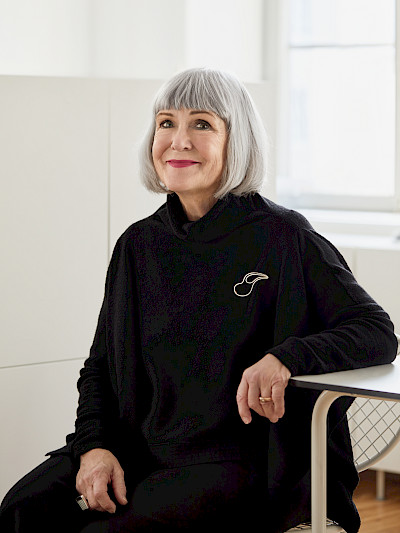
“Nola has a long and memorable history with the furniture fair and especially the Greenhouse pavilion,” says Nola's founder Agneta Stake. “It’s where we first met many of the designers we work with today. So, for the 2023 fair, we wanted to try something new that aligns more with our values of social sustainability and the mandate to make the city accessible to everyone. That’s why the initiative to design and furnish the Greenhouse café was especially welcomed.”
Designers Anki Gneib and Mia Cullin were commissioned to design the space, working exclusively with materials that were reused, recycled or could be returned to the supplier for reuse after the fair ended. Their inspirations came from urban space and its architecture, parks and squares - all spaces where Nola's products create places to meet, work and relax. The design had multiple benefits. As the need for building materials was decreased, it heightened the potential to create an open and accessible space where visitors could interact.
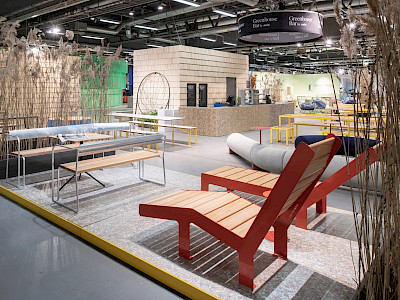
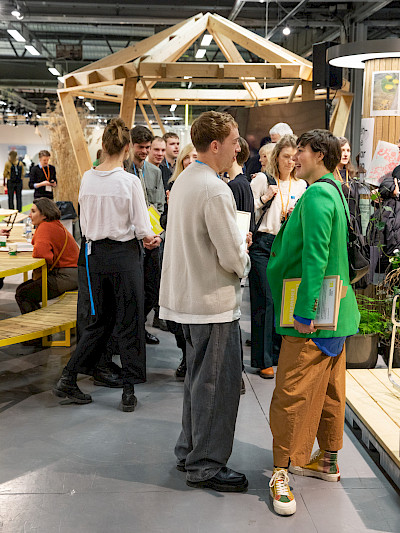
“In the larger area of the café, we were able to display more of our range, but also bigger products and items that occupy a bigger surface area,” says Henrik Edlund, Nola’s CEO. “As a result, it presented a fairer picture of how urban space is constantly evolving and how we move with it. We are happy that we could contribute to specific needs at the fair and more generally to sustainability overall.”
Nola met the café’s needs through products such as the Långbordet table, the Kajen sunbed lounger and the Hexagon H22 pavilion, designs that are able to define and demarcate spaces by themselves. That meant that fewer installation elements had to be built, which reduced the number of temporary structures needed on site.
“Nola's initiative made the Greenhouse café appear well-designed and cohesive without requiring many built elements,” says Jennifer Gröhn, project manager for the Greenhouse. “To make the few things that still needed to be built, we found materials that could be reused, recycled and recirculated once the fair was over.”
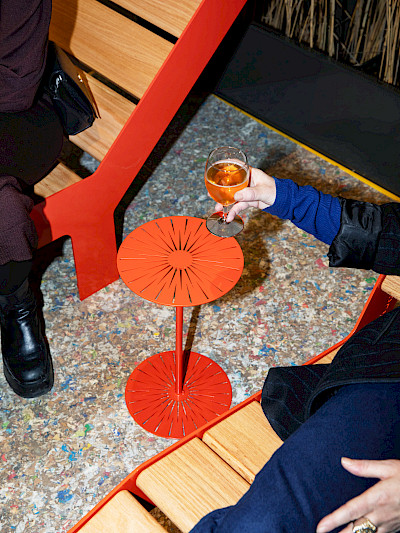
So, where did it all go afterwards?
Before the fair started, Nola determined that the products on display would be sold at a discount in a wholesale collection called ‘Resourceful’. The Hexagon H22 pavilion was sold even before the fair opened, followed by the Långbordet table, an Areal table and corresponding benches and a fully-furnished Parklet mini park. The remaining products were sent back to Nola's warehouse or to the places they had been borrowed from. Even the roof over the café was recycled, as Hälsinge Takspån reclaimed the wooden shingles covering it and sold them for reuse.
“The roofing shingles used at the fair are currently up for sale at a slightly reduced price,” says Petter Klasson, CEO of Hälsinge Takspån. “Their condition is still very good, but some of them were pierced by nails. We thought it was great to see our material used in a new context at the furniture fair and hope that more designers will be open to reusing materials in interior spaces too. "

Similarly, the material used to construct the fair’s podium was returned to Recoma for reuse. Other custom-built items, such as the bar countertops, were stored for reuse at future fairs. Anki Gneib and Mia Cullin were able to salvage the reeds that divided some of the seating areas for reuse at future events.
“This is an example of a collaboration that we have learnt from,” says Jennifer Gröhn, “thanks to the exhibitor wanting to participate without building a traditional stand. For us, the benefit was that we reduced the production and construction of structures. We were already aiming to minimise construction waste in our exhibitions, cafés and seating areas, and together with Nola and their products, we found a creative solution.”
For the 2023 furniture fair, the organisers partnered with Swedish materials merchants Beijer Bygg, who were able to salvage 4.5 tonnes of timber by reselling it as recycled wood. Temporary interior structures built for exhibitions at the fair, such as those for design group Front’s installation and designer Emma Olbers’ ‘Now or Never – 1kg CO2e ’ exhibition, will be reused at museums and design centres later this year.
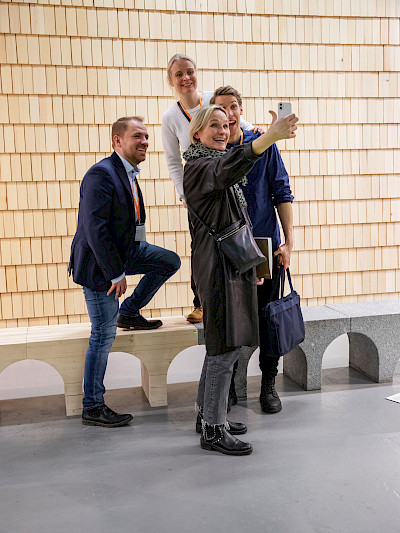
“Don’t forget that in addition to providing a physical place, a trade fair also creates space for thoughts, ideas and the sharing of knowledge”
Henrik Edlund, Nola’s CEO
“Don’t forget that in addition to providing a physical place, a trade fair also creates space for thoughts, ideas and the sharing of knowledge,” says Henrik Edlund. “We’re pleased that Stockholm Furniture Fair’s organisers thought about closing this loop as well, and that the knowledge gained can live on and inspire more people in new places.”
For Nola, participating in the fair with a zero waste approach dawned a whole new perspective on exhibiting. There were strategies in place before and after, leaving nothing to chance or to spontaneous decisions. Every product or item brought into the café was documented in advance and had its final destination recorded in an Excel spreadsheet.
“Now it's very much about looking at the value of a product in new ways,” says Henrik Edlund. “Our furniture is made to last for a long time and to be used in heavily trafficked environments. The fact that we were able to resell the products and furniture used in the Greenhouse even before the fair opened says a lot about their quality and durability. It feels good to be able to create products that have double value. In this case, through use at the fair, then again in new locations in other parts of the country,” he concluded.
